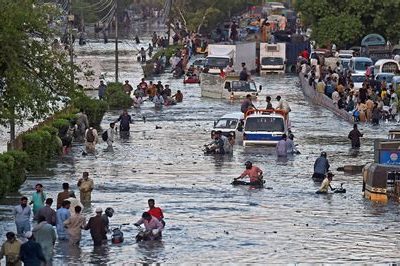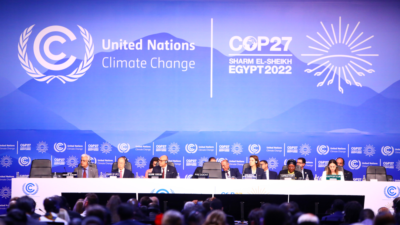Loss and Damage
A deeper dive into the top issue at COP27

As I noted in my last post, this year’s conference of the parties to the climate treaties (COP27) became pretty much a single-issue conference, focused on adaptation and the associated needs for finance – in particular on the urgent need for financial assistance to support adaptation in the Global South, and the lamentable record of unfulfilled promises for climate finance. Even within the broad area of adaptation, the COP mainly focused on the specific issue of “Loss and Damage” (L&D). The decision to establish a separate financial mechanism for L&D, agreed in the last hours of the conference, was the one notable achievement of COP27. In this post, I take a deeper dive into the issue of loss and damage – what it means, its history, the status of debates, and its significance.
L&D has a specific meaning in climate talks that may not be obvious to anyone not immersed in the process: harms caused by climate change that are not avoided by adaptation. Given any particular trajectory of realized climate change (which of course depends on how fast emissions are cut), adaptation measures (e.g., more robust infrastructure, new crop varieties) reduce the resultant harm to people and things they care about. But not all harms will, or can, be avoided through adaptation, particularly for fast or extreme changes. To the extent adaptation falls short – whether because effective adaptation actions aren’t available or because available adaptation actions aren’t taken – the remaining harms are called L&D.
Like any climate-change impacts, L&D can take diverse forms — economic losses or harms to human health and welfare, to environmental characteristics that people value, to social or cultural practices – basically, any harm that matters to affected people and communities. Although L&D is conceptually distinct from adaptation – adaptation reduces realized harms from climate change, while L&D is the remaining residual harm after adaptation – in practice the distinction is blurry, due to uncertainty about how to adapt effectively in each context, how well adaptation will be done, and limits to feasible adaptation. Although residual damages after adaptation will occur worldwide, the term L&D conventionally refers to such losses and responses to them in developing countries.
L&D has long been present in climate debates, but movement toward concrete action has been slow. Even before adoption of the 1992 Framework Convention, the Alliance of Small Island States (AOSIS) had proposed an “International Insurance Pool” to pay vulnerable countries based on observed sea level rise. The first explicit use of the term L&D was in the 2007 Bali Action Plan, in a section on enhanced action for adaptation. After several years of deadlock, parties established a work program on L&D in 2012 (at COP17 in Durban), further formalized in 2013 as the Warsaw International Mechanism for Loss and Damage (WIM). In the 2015 Paris Agreement, Article 8 acknowledged the importance of L&D and the accompanying decision 1/CP.21 extended the WIM mandate, yet Paragraph 51 of the same decision stated that Article 8 provided no basis for climate-related liability or compensation. COP 25 established the Santiago Network to provide technical support related to L&D – again with no implementation or funding. Arguments for a separate L&D financial vehicle gained strength in Glasgow (COP26, 2021), but disagreement persisted until the last-minute agreement to establish one at the end of last month’s COP27. This does represent another step in the direction of concrete action, even though all matters of implementation and funding were deferred to future negotiations.
 Why is L&D so contentious? Since L&D is in some sense just another form of North-South finance, it raises familiar disagreements from long-standing debates over climate finance and general development assistance: How much will be paid, to whom, for what purpose, in what form, from what source, with what conditions, and under what control? There are a couple of wrinkles that distinguish L&D from these other issues. First, what are the implications of creating a separate new vehicle for L&D: This raises the prominence of the topic and might motivate increases in support, at the cost of more bureaucratic complexity and potential confusion and redundancy between funding vehicles. Second, what will the new fund be spent on and how will its scope be defined in practice? Designating a funding mechanism for adaptation, or for that matter for climate, implies certain boundaries for expenditures that are conceptually clear, even if hard to implement cleanly in practice. But by assumption, L&D finance is not directed to avoiding harms but to providing financial compensation for harms already incurred, so it’s not clear whether there will, or should, be limits on what it’s spent on. These are significant and novel challenges for L&D, but they do not fundamentally distinguish it from other climate or development finance.
Why is L&D so contentious? Since L&D is in some sense just another form of North-South finance, it raises familiar disagreements from long-standing debates over climate finance and general development assistance: How much will be paid, to whom, for what purpose, in what form, from what source, with what conditions, and under what control? There are a couple of wrinkles that distinguish L&D from these other issues. First, what are the implications of creating a separate new vehicle for L&D: This raises the prominence of the topic and might motivate increases in support, at the cost of more bureaucratic complexity and potential confusion and redundancy between funding vehicles. Second, what will the new fund be spent on and how will its scope be defined in practice? Designating a funding mechanism for adaptation, or for that matter for climate, implies certain boundaries for expenditures that are conceptually clear, even if hard to implement cleanly in practice. But by assumption, L&D finance is not directed to avoiding harms but to providing financial compensation for harms already incurred, so it’s not clear whether there will, or should, be limits on what it’s spent on. These are significant and novel challenges for L&D, but they do not fundamentally distinguish it from other climate or development finance.
But there is another, more basic point of disagreement over L&D that distinguishes it strongly from other climate or development finance: what is the basic understanding of what L&D payments are, and the reason for them? There are two prominent views on this matter: L&D might be considered compensation owed for harm caused by past actions; or it might be a mechanism to insure shared risks. These two views have been present since early days of climate negotiations, but debate over them has grown increasingly heated since Paris. The stakes could be very high.
If L&D is conceived as compensation owed for harms caused by past actions, it is analogized to tort liability. The harm-causing actions to which liability attaches are past emissions, ascribed either to nations or enterprises in proportion to their contribution to the present excess atmospheric burden of greenhouse gases. Assigning responsibility for these is a major theme in ongoing suits in several jurisdictions trying to hold fossil producers or emitters liable for climate damages, but in L&D debates the responsible parties are generally assumed to be national governments. The high-income industrialized countries dominate this accounting based on their cumulative historical emissions since the industrial revolution, even though developing countries have now surpassed industrialized countries in current emissions and will likely do so in cumulative emissions within a couple of decades. Moreover, the industrialized countries got rich on those emissions with cheap fossil fuels driving their economic growth, while the developing countries are both smaller contributors to current climate change and more vulnerable to impacts. They are thus entitled to compensation for the resultant harms – past and present, and presumably also future, although shares of responsibility will shift over time with global patterns of current emissions.
There are a few challenges to this framing of L&D, both conceptual and practical. Does the responsibility attach to the industrialized countries as state actors, or to the enterprises under their jurisdiction that were actually responsible for past emissions? In effect, how valid is the analogy from claimed liability against fossil producers or emitters for climate damages under domestic legal systems? How far back in time will current and coming climate harms be deemed to have been sufficiently foreseeable to attach liability? How far into the future will such liability based on past emissions be extended – and how can this conception of L&D account for changes in emissions shares over time, in particular the dominance of developing and middle-income countries in current emissions? In this regard, it’s worth noting China’s statement at COP27 that it supports L&D funding, but as a developing country will have no responsibility to contribute. (Its statement referred back to the lists of countries in Annexes to the original Framework Convention, which roughly captured the Developed/Developing divide as it stood in 1992).
Even as industrialized countries have moved toward cautious support for L&D finance, they have fiercely resisted this conception. They even required the language in Paragraph 51 stating that Article 8 does not “involve or provide a basis for any liability of compensation” as a condition of approving Article 8. Their principal reason for this opposition is resisting the associated normative assignment of fault, along with the potentially unlimited liability to compensate for future weather and climate-related harms that might follow.
Under the second alternative framing, L&D payments are analogized not to compensation for tort liability, but to an insurance system. Payments would be understood not as compensation for the consequences of wrongful acts, but as payouts based on pooling uncertain risks, to those who experience realized harms. Several major practical differences follow from this framing. Payments would be contractually agreed rather than assessed based on an adjudication of responsibility and damages. Terms and conditions for payouts would thus be specified voluntarily in advance, and their size limited by these negotiated terms. Funds would come from agreed advance contributions, analogous to payment of insurance premiums. Responsibility for these premium payments can be broadly shared, and can shift over time, whether based on changes in shares of cumulative emissions, development status, financial capacity, vulnerability, or other measures. But however the payments are raised and distributed, they carry no attribution of fault.
As you might expect, the developing countries pressing for more attention to L&D have generally favored the liability model, while the industrialized countries – including those who belated yielded to pressure to support an L&D financial facility – strongly favor the insurance model. The insurance model also has limitations. For example, payments do not necessarily fully compensate harms. But it also has significant advantages, in particular the flexibility of negotiated terms – including the distribution of responsibility for premium payments and the possibility of blending market-pricing arrangements with various levels of subsidy.
 There are several existing models for an insurance-based L&D facility, in current regional pools that insure extreme weather events. Such systems exist in the Caribbean, Africa, Pacific Islands, and Southeast Asia, with variation in precise arrangements such as what risks are covered, whether participants are states or private parties, payout levels and the source and level of subsidies. There is also a facility, called InsuResilience, that integrates these systems and provides some degree of reinsurance.
There are several existing models for an insurance-based L&D facility, in current regional pools that insure extreme weather events. Such systems exist in the Caribbean, Africa, Pacific Islands, and Southeast Asia, with variation in precise arrangements such as what risks are covered, whether participants are states or private parties, payout levels and the source and level of subsidies. There is also a facility, called InsuResilience, that integrates these systems and provides some degree of reinsurance.
A recent German proposal, called the Global Shield Against Climate Risks, would extend, strengthen, and link these systems with other financial programs for climate adaptation and disaster preparedness and response. Proposed as a major initiative of Germany’s 2022 Presidency of the G-7, the Global Shield would aim to integrate multiple governmental, intergovernmental, and private-sector financial systems (insurance, loans, grants, designated reserves, etc.), together with preparedness plans and early warning systems, to address present gaps and provide more effective, accessible, and timely responses to severe weather and climate-related events. Germany introduced the proposal in March 2022, initially as a pilot partnership with 5 to 10 highly climate-vulnerable countries. The proposal was discussed by G7 development ministers and leaders, and supported n their communiques – the first time the G7 has recognized the importance of L&D. Subsequent discussions in September between the G7 and the V-20 group of most vulnerable countries also generated broad support for the proposal, although with continuing differences over the need for a new central facility and the ability of such a broadly scoped facility to effectively target L&D, as well as long-standing concerns about governance and adequacy of financial resources.
Germany continued to promote the Global Shield proposal at COP27, to mixed reviews. But debates over how to implement and fund L&D ultimately took back seat to the basic decision whether or not to establish a L&D finance facility at all. Having decided to do so, Parties deferred all related decisions – what the new facility will do, how it will operate, and how and by whom it will it be funded – to future COPs.
So what happens now? From here on I’m speculating about future events, but here are a few guesses:
-
- First, this decision does not end the conflicts over L&D. The belated switch of the US and other industrialized countries to support a L&D facility was more a practical response to the perceived need to salvage something from this COP than it was a deep change of heart to stronger commitments to compensating the current and future losses of developing countries to climate change. Those future negotiations about implementation and funding will be slow and difficult, and it’s not even assured that there will not be back-sliding on the agreement to establish the separate facility.
- Second, between the two basic conceptions of L&D, the industrialized countries are likely to stick strongly to accepting only the insurance framing. They are unlikely to accept the ascription of blame and unlimited financial exposure implied by the liability and compensation model. For their part, the developing countries mainly need the money, and are likely to accept the characterization as insurance if the payments are adequate and the responsibility for contributions appropriately distributed. It is even possible that delegates may find some way to finesse the language used to describe the initiative, to pursue some degree of compromise between the two conceptions. In this regard, recent proposals to call some or all of the funding “solidarity payments” seem to strike a nice balance and might have promise.
- In any case, it is more urgent to get money flowing, in meaningful amounts, than to continue fights over the terms of future obligations. I suspect this is a point on which all parties are likely to (eventually) agree, and the German Global Shield proposal is well crafted, flexible, and likely to facilitate a substantial increase in resources — even if these remain smaller than total losses.
- More broadly, while it is imperative to greatly increase flows of climate finance — no matter how the relationship between adaptation finance and L&D is characterized — these matters are only weakly linked to the actions needed to actually reduce future climate risks. The need for concrete progress on rapidly cutting emissions, scaling up atmospheric removals, and developing understanding and capability for engineered climate interventions, remains acute. These are the activities that will reduce the extremity of future climate change to which adaptation efforts must adjust, or for which L&D payments must compensate. The longer these efforts remain weak, the more likely it is that changes will exceed capability either to adapt or to compensate through L&D payments.
This post is based on work done in the Fall 2022 UCLA Emmett Institute’s Clinic on International Climate Change Law and Policy, with contributions by Veronika Bagi, Karen Meacham, Wietske Merison, and Melissa Rodrigues. I am responsible for any interpretations, opinions, or errors.







Reader Comments